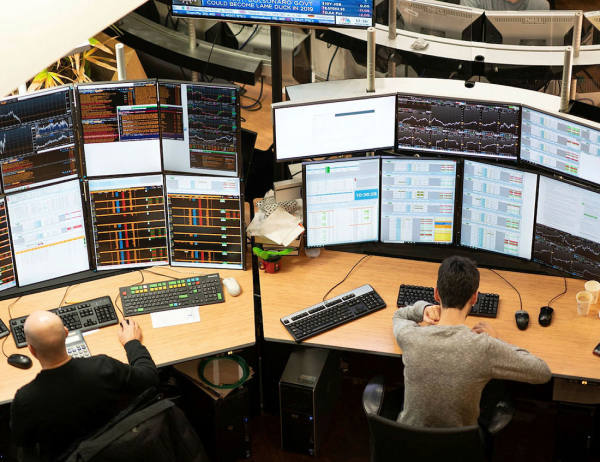“Be fearful when others are greedy and be greedy only when others are fearful,” is, as modern investing maxims go, about as canon as it gets. Even by the standards of Warren Buffett – whose every public utterance is parsed by millions of acolytes, like decrees sent from on high – it’s one of the undisputed greatest hits.
Middle-period (pre-Buffett-backed) Apple put it more succinctly, with its ‘think different’ line. For investors, the implication is the same: if you want to make real money in the stock market, and protect yourself against its worst excesses, you can’t do the same thing as everyone else.
But what, exactly, are we referring to here? Close reading of the Buffett oeuvre suggests his target was broad. In his 1986 letter to shareholders, he referred to fear and greed as two species of “super-contagious disease”, with an epidemic-like quality that spreads across a market. That incurable human tendency to extremes and crowding. One which, as the S&P 500’s forward earnings ratio hits heights not seen this century, finds Buffett fearful (and in a fortress of cash).
Still, it is stocks that make a market. And on any given day, in the UK market at least, there are plenty of companies valued at levels that suggest investors are at best doubtful, at worst fearful.
Should we automatically get greedy in these instances? Over the years, Buffett’s north star has changed from cheapness and margins of safety to quality companies whose equity trades at a ‘fair’ price. While this investing strategy has a lot to recommend it – including the tendency of sector-leading companies to deliver consistently, for years or decades – this move could be seen as a vote against greed or the belief that markets can simply fail to recognise bargains.
Our Have it All screen isn’t as experienced as Mr Buffett. But since it entered service in 2011, it has taken the view that a ‘best-of’ Buffett approach is possible. By hunting for stocks offering growth, quality and cheapness, it wants it all. A ‘buffet’ approach, then.
| Name | TIDM | Total Return (5 Dec 2023 - 28 Nov 2024) |
| Plus500 | PLUS | 84.3 |
| Intermediate Capital | ICGT | 38.8 |
| TBC Bank | TBCG | 27.3 |
| Telecom Plus | TEP | 17.5 |
| OSB Group | OSB | 15.1 |
| ICG Enterprise Trust | ICGT | 8.1 |
| Liontrust AM | LIO | -8.5 |
| Record | REC | -9.1 |
| Ultimate Products | ULTP | -15.9 |
| FTSE All-Share | - | 15.0 |
| Have It All | - | 17.5 |
| source: LSEG | ||
The screen has been more successful than not. This year’s 2.5 percentage point outperformance of its benchmark, the FTSE All-Share, is the screen’s ninth in the 13 years we have monitored it. That lifts its total return to 216 per cent, equivalent to a compound annual growth rate of 9.3 per cent.

Although the stocks mentioned in these pages are intended as ideas for further research rather than off-the-shelf portfolios, if we factor in a 1 per cent annual charge to reflect real-world dealing costs, the total return falls to 177 per cent, compared with 156 per cent if you simply bought and left well alone a total-return version of the All-Share index.
The screen’s full criteria are as follows:
VALUATION TESTS
■ Forecast next-12-month price/earnings (PE) ratio among the lowest third of all stocks screened.
■ Forecast next-12-month dividend yield (DY) in the highest third of all stocks screened.
■ Forecast next-12-month free cash flow yield (FCF yld) in the highest third of all stocks screened.
GROWTH & QUALITY TESTS
■ Average forecast earnings per share (EPS) growth in the next two financial years of 5 per cent or more.
■ Three-year EPS compound annual growth rate (CAGR) of 10 per cent or more.
■ Three-year free cash flow CAGR of 10 per cent or more.
■ Three-year dividend CAGR of 5 per cent or more.
■ Return on equity (RoE) of 10 per cent or more.
■ Three-year average RoE of 15 per cent or more.
This year, as with several previous refreshes, no FTSE All-Share constituent passed every test. Seemingly, it’s not quite possible to have it all, at least as our screen defines it.
As has been the case since 2021, I have admitted stocks that fail two of the tests, so long as at least one of them is a valuation test. This generates nine stocks, which marks an improvement on last year, when a paucity of selections meant I had to admit stocks that failed three tests.
Two things are clear from this year’s selections. The first is that, like our recently refreshed Genuine Growth screen, this methodology has taken a shine to banking stocks. This year, four companies – Kent Reliance-parent OSB (OSB), motor finance specialist S&U (SUS) and the Tbilisi-headquartered Bank of Georgia (BGEO) and TBC Bank (TBCG) – all make the cut. And no wonder: while the past three years have seen strong income growth, with more to come as interest rates remain high, markets are instinctively nervy about the sustainability of profits.
The second is the annual reminder that despite its name, the screen doesn’t care for momentum. Two stocks – 2023 returnee Ultimate Products (ULTP) and S&U – have had an especially rocky past year, while the average share price move of the past quarter is a loss of 6.6 per cent. Of course, it’s possible to have forecast earnings growth and a falling share price. But this might simply reflect a big hit to margins, analyst slowness in updating their forecasts, or new risks (such as S&U’s ensnarement in the Financial Conduct Authority’s review of commissions on car finance).
This, I would argue, is a slight defect in the screen’s approach. Unlike Buffett (although like all the screens in our stable) the Have-It-All takes an ‘always-in’ view of equities, meaning widespread, big and sudden drops in risk tolerance are hard to avoid. Such is its lot.
Details of all the stocks that met the diluted tests can be found in the table below, along with details on the tests they failed. A downloadable spreadsheet is also available in the online version of this article.
| TESTS FAILED | Name | TIDM | Mkt Cap | Net Cash / Debt(-)* | Price | Fwd PE (+12mths) | Fwd DY (+12mths) | FCF yld (+12mths) | CAPE | EBIT Margin | ROCE | 5yr Sales CAGR | 5yr EPS CAGR | Fwd EPS grth NTM | Fwd EPS grth STM | 3-mth Mom | 3-mth Fwd EPS change% |
| FCF grth | Man Group | EMG | £2,480mn | -£130mn | 209p | 7 | 6.9% | 11.2% | 15.6 | 24.6% | 15.7% | 4.4% | 4.3% | 23% | 20% | -6.0% | -4.9% |
| Hist. EPS grth | Ultimate Products | ULTP | £108mn | -£15mn | 120p | 8 | 6.4% | 10.4% | 13.5 | - | 22.7% | 4.8% | 8.7% | 17% | 13% | -18.1% | 1.5% |
| Fwd EPS grth | RHI Magnesita | RHIM | £1,456mn | -£1,024mn | 3,100p | 7 | 5.2% | 13.0% | 15.7 | 6.5% | 12.3% | 2.6% | -0.5% | 7% | 10% | -6.1% | -3.9% |
| FCF yld | Foresight | FSG | £520mn | £37mn | 420p | 10 | 6.3% | - | 20.7 | - | 39.6% | - | - | 33% | 19% | -19.2% | -1.2% |
| DY, RoE | Macfarlane | MACF | £166mn | -£43mn | 105p | 9 | 3.6% | 10.6% | 16.6 | 8.5% | 14.5% | 5.3% | 11.2% | 5% | 5% | -8.7% | -1.4% |
| FCF yld, FCF grth | S&U | SUS | £169mn | -£240mn | 1,400p | 6 | 9.2% | - | 6.7 | - | 16.5% | 6.8% | -2.1% | 31% | 14% | -21.6% | 3.5% |
| FCF yld, FCF grth | OSB | OSB | £1,429mn | -£4,078mn | 397p | 5 | 8.0% | - | 7.4 | - | - | 34.0% | 3.5% | 2% | 13% | 6.3% | -1.8% |
| FCF yld, DPS grth | Bank of Georgia | BGEO | £2,225mn | -£1,300mn | 4,995p | 4 | 6.0% | - | 12.2 | - | - | 19.3% | 24.6% | 15% | 23% | 10.0% | 6.9% |
| FCF yld, DPS grth | TBC Bank | TBCG | £1,781mn | -£431mn | 3,220p | 4 | 8.5% | - | 11.6 | - | - | 20.3% | 21.6% | 19% | 17% | 4.0% | 11.3% |
| Source: FactSet. * FX converted to £. NTM = Next Twelve Months. STM = Second Twelve Months (ie one year from now) | |||||||||||||||||




.jpg?source=invchron&width=600)




